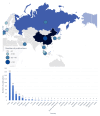Application of Kolcaba's Comfort Theory in healthcare promoting adults' comfort: a scoping review
- PMID: 39389601
- PMCID: PMC11474854
- DOI: 10.1136/bmjopen-2023-077810
Application of Kolcaba's Comfort Theory in healthcare promoting adults' comfort: a scoping review
Abstract
Background: Comfort is a primary goal of healthcare. Theory-informed interventions and measurement are essential for comfort enhancement.
Objectives: To categorise and synthesise the international literature on the application of Kolcaba's Comfort Theory in research and practice aiming to promote adults' comfort.
Eligibility criteria: Papers reporting the application of Kolcaba's Comfort Theory on adult participants published in English and Chinese.
Sources of evidence: MEDLINE, CINAHL, APA PsycInfo, Embase, AMED, Web of Science, Scopus, The Cochrane Library, JBI EBP Database, CNKI, Wan Fang; grey literature of Google Scholar, Baidu Scholar and The Comfort Line were searched from January 1991 to January 2024.
Chart methods: Following the Joanna Briggs Institute guidance and Preferred Reporting Items for Systematic Reviews and Meta-Analyses extension for Scoping Reviews checklist, two reviewers selected papers and extracted data independently using a standardised chart embedded in NVivo software. A thematic synthesis and a descriptive analysis were provided.
Results: The review included 359 papers. Approximately two-thirds (n=216, 60.2%) had been published since 2017. The majority of papers (n=316, 88.0%) originated from China, the USA, Turkey, Brazil and Portugal. The use of Kolcaba's Comfort Theory was dominated in a range of hospital settings (n=263) and with participants suffering neoplasms (n=55). Seven categories of theory application were identified: (I) interventions underpinned by Comfort Theory as the theoretical framework, (II) interventions evaluated by instruments derived from Comfort Theory, (III) descriptive or observational studies of services or practices underpinned by Comfort Theory, (IV) surveys using questionnaires derived from Comfort Theory, (V) questionnaires development or adaption based on Comfort Theory, (VI) qualitative studies interpreted by Comfort Theory and (VII) literature reviews and discussion about Comfort Theory use. The most commonly evaluated interventions included music therapy (n=31), position intervention (n=20) and massage (n=19), and the most commonly used questionnaire was General Comfort Questionnaire (n=109).
Conclusions: Kolcaba's Comfort Theory has been largely used in interventions and assessments across a wide range of contexts, providing a set of options for practitioners. However, quantifying evidence is needed through further systematic reviews, and continuous development of Comfort Theory is warranted based on the categorisation by this review.
Keywords: Adult palliative care; Complementary Medicine; Pain Management; Systematic Review.
© Author(s) (or their employer(s)) 2024. Re-use permitted under CC BY-NC. No commercial re-use. See rights and permissions. Published by BMJ.
Conflict of interest statement
Competing interests: None declared.
Figures




Similar articles
-
Interventions and practices using Comfort Theory of Kolcaba to promote adults' comfort: an evidence and gap map protocol of international effectiveness studies.Syst Rev. 2023 Mar 6;12(1):33. doi: 10.1186/s13643-023-02202-8. Syst Rev. 2023. PMID: 36879339 Free PMC article.
-
Beyond the black stump: rapid reviews of health research issues affecting regional, rural and remote Australia.Med J Aust. 2020 Dec;213 Suppl 11:S3-S32.e1. doi: 10.5694/mja2.50881. Med J Aust. 2020. PMID: 33314144
-
Suggesting a Practical Theory to Oncology Nurses: Case Report of a Child in Discomfort.J Palliat Care. 2018 Oct;33(4):194-196. doi: 10.1177/0825859718763645. Epub 2018 Mar 21. J Palliat Care. 2018. PMID: 29560797
-
Use of non-pharmacological interventions for comforting patients in palliative care: a scoping review.JBI Database System Rev Implement Rep. 2017 Jul;15(7):1867-1904. doi: 10.11124/JBISRIR-2016-003204. JBI Database System Rev Implement Rep. 2017. PMID: 28708751
-
Evidence-informed practice versus evidence-based practice educational interventions for improving knowledge, attitudes, understanding, and behavior toward the application of evidence into practice: A comprehensive systematic review of UG student.Campbell Syst Rev. 2022 Apr 16;18(2):e1233. doi: 10.1002/cl2.1233. eCollection 2022 Jun. Campbell Syst Rev. 2022. PMID: 36911346 Free PMC article. Review.
References
-
- Kolcaba K, Crawford CL. In: Middle Range Theories: Applicatoin to nursing research and practice. Peterson SJ SJ, Bredow TS TS, editors. London: Wolters Kluwer; 2020. Comfort; pp. 189–209.
-
- Bice A, Kolcaba K. Katharine Kolcaba’s Comfort Theory. 5 th edn. FA Davis; 2020.
-
- Nightingale F. In: Nursing theories and nursing practice. Smith MC, editor. London, UK: DAppleton & Co; 1860. Notes on nursing: what it is and what it is not.
Publication types
MeSH terms
LinkOut - more resources
Full Text Sources
Research Materials
